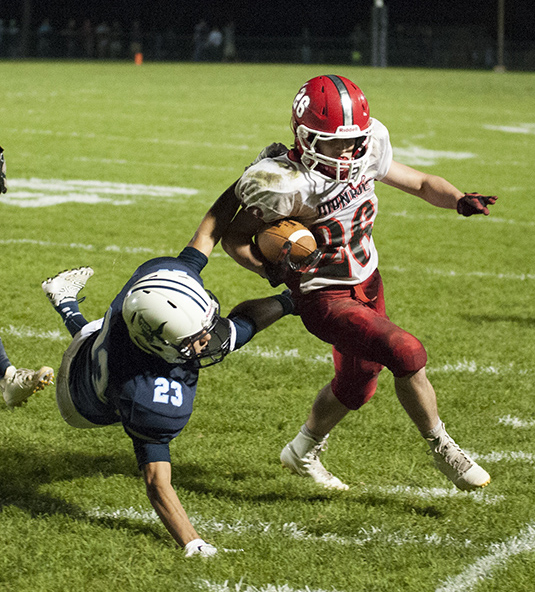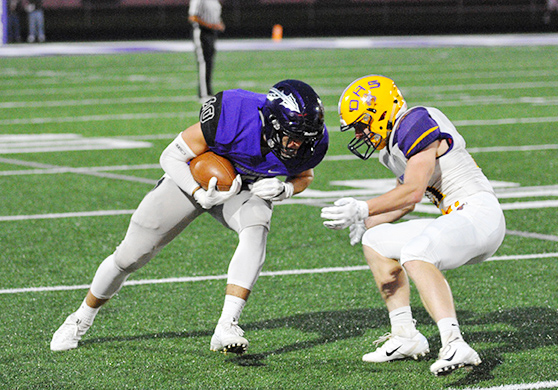Football: Defense in the ‘coming out’ zone

Ask any football coach, and he’ll tell you that the most important area or zone on the field is the red zone. He’ll also tell you that the success or failure of a team usually rides on how well it executes in the 20-to-goal-line area.
Even fans know why the red zone is so important. The announcers are always quoting a litany of statistics on each team’s success or failure in this zone.What many people, and some coaches, fail to realize is that just as many games are won or lost in the “coming out zone,” the area from the goal line to the 20-yard line on the offense’s side of the field. It may not be as mystical as the so called red zone, but it can prove just as meaningful.
Allow us to explore the mindset of many offensive play callers and the types of plays they may dial up when their own backs are to their goal line.
Even though we consider the whole area from the goal line to the 20-yard line the coming out zone, we will divide the zone into two separate parts — the area from the goal line to the 10, and the area from the 10 to the 20. These two subdivisions may have a lot of similarities, but some minute differences have to be understood.
The ‘backed-up zone’ (goal line to the 10)
Psychologically, this is one of the most vital parts of the field. If the offense can move the ball out of this area, it can inflict a lot of psychological damage on the defense and brighten their own mental outlook.
The offense’s primary goal in this area is to gain at least one first down, and the benefits are two fold. Strategically, it’s important because it facilitates a punt, allowing the ball to be launched on the field side of the goal line rather than the end zone. Quarterback sneaks are common in this situation, especially if the ball is butted up against the goal line.
Normally, the offense gives the ball to sure-handed players. Play selection may favor short-yardage gains with wedge blocking. Offensive coordinators may select closed-type formations. In some cases, a wing may be used to add another gap to the defensive front and stop pressure off the corner.
Complicated blocking schemes are usually avoided. Passes will probably be of a low and outside nature. Passes over the middle are usually avoided because of the possibility of a big hit or a tipped pass.
However, this also is a prime time to throw long outside. Some offenses see this as a great time to take a shot, because the defense has to defend 90-plus yards of grass. A long pass that is intercepted might be considered better or as good as a punt.
‘Backed-up zone’ defense
Defensive thinking and strategy should be to limit the opponent to no more than one first down. Good defensive tactics in this area includes inside line changes that might come clean and result in negative yardage or a holding call. Scheme to take away the sneak or at least make the quarterback slide out to the B gap. Corners should be drilled to expect a double move; That is a quick and go, out and up, slant and up.
The defensive huddle call should incorporate the use of a deep middle or hole player to ensure over-the-top help and an advantageous position to field a possible quick kick.

The defense must take care in applying pressure on the offense by sacrificing in-depth alignments. A crowding the line-of-scrimmage mentality can produce a gap-responsibility bust or a loss of gap-integrity, allowing a big play.
Pressure should be judiciously used. One play from the late 1980s comes to mind. During a preseason scrimmage, we had a team backed up on its 1-yard line and we dialed up a pressure defense with man coverage. Our corner fell down on a slant route and the receiver went 99 yards for a touchdown. This can devastate a team’s psyche, so be careful.
The ‘green zone’ (10 to the 20)
Some coaches refer to this as the green zone, an extension of the backed-up zone. The offensive thought process, for the most part, is usually the same here as it was for the backed-up area. The Cardinal Rule is to get a first down.
Slight differences may occur, however. For example, the offense can open it up a little more here than it could when it was deeper in its own end. Quarterback sneaks are less prevalent here.
Another difference is that a penalty will not result in a safety. Ball security is still a must. Trick plays, such as reverses or double passes, are minimal.
However, it’s still a great time to attack vertically with a long pass. The quarterback’s reads should be quick and well defined, and he should avoid holding the ball for any length of time.
Passes should be thrown on time, and pass protection is highly important. Backs who check release will ensure extra blockers should the defense bring pressure. Motion may be used to help with pre-snap reads, and play action passes are possible.
The running game probably consists of base-type runs with power or man blocking. Handoffs are probably more preferable than toss or pitch type plays. Counters are risky, and quick-tempo plays will probably be the norm. Plays with yardage loss potential should be avoided. The offense wants to stay on schedule and not be faced with a long-yardage play.
‘Green zone’ defense
Defensive strategy in this area should be to get a stop and be in position to receive a punt around the 50-yard-line. Defenses should be taught to think turnovers. Zone coverages are safer than man coverages. A five-under, two-deep scheme that disrupts routes would be effective in this zone.
Regardless of the overall defensive philosophy a team subscribes to, coaches and players should understand that the seeds of victory or defeat can be sown in the “coming out” area.
Kenny Ratledge spent more than 30 years as a defensive coordinator in high school football.





